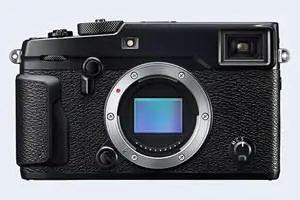Fujifilm X-Pro2 vs Panasonic FZ2000
The Fujifilm X-Pro2 and the Panasonic Lumix DMC-FZ2000 (labelled Panasonic FZ2500 in some countries) are two digital cameras that were officially introduced, respectively, in January 2016 and September 2016. The X-Pro2 is a mirrorless interchangeable lens camera, while the FZ2000 is a fixed lens compact. The cameras are based on an APS-C (X-Pro2) and an one-inch (FZ2000) sensor. The Fujifilm has a resolution of 24 megapixels, whereas the Panasonic provides 20 MP.
Below is an overview of the main specs of the two cameras as a starting point for the comparison.

Check X-Pro2 offers at
ebay.com

Check FZ2000 price at
amazon.com
Going beyond this snapshot of core features and characteristics, what are the differences between the Fujifilm X-Pro2 and the Panasonic Lumix DMC-FZ2000? Which one should you buy? Read on to find out how these two cameras compare with respect to their body size, their imaging sensors, their shooting features, their input-output connections, and their reception by expert reviewers.
Body comparison
An illustration of the physical size and weight of the Fujifilm X-Pro2 and the Panasonic FZ2000 is provided in the side-by-side display below. The two cameras are presented according to their relative size. Three consecutive views from the front, the top, and the rear side are shown. All width, height and depth dimensions are rounded to the nearest millimeter.
The X-Pro2 can be obtained in two different colors (black, graphite), while the FZ2000 is only available in black.
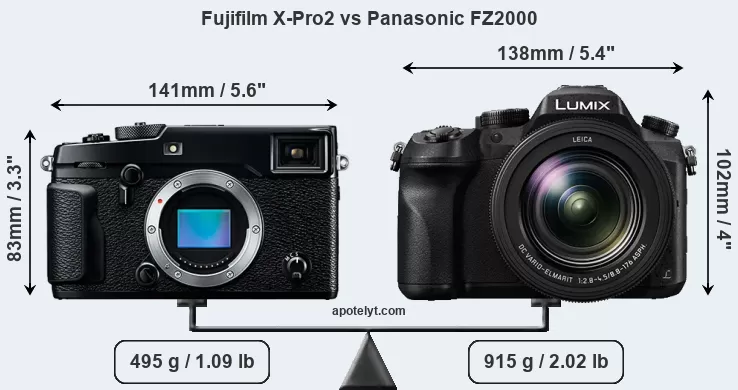
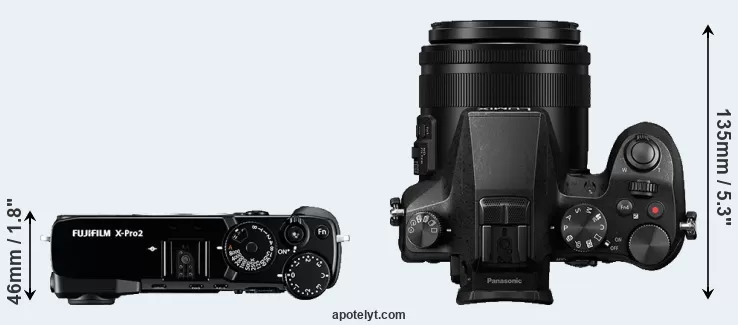
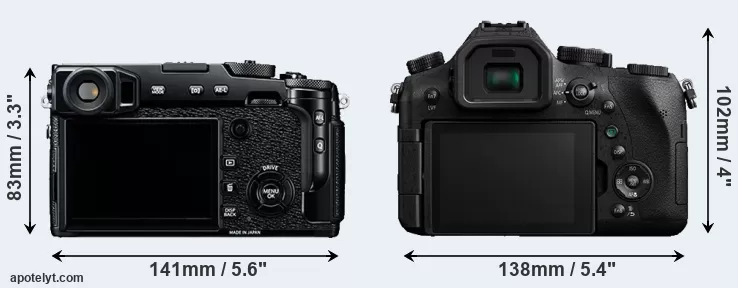
If the front view area (width x height) of the cameras is taken as an aggregate measure of their size, the Panasonic FZ2000 is notably larger (20 percent) than the Fujifilm X-Pro2. It is worth mentioning in this context that the X-Pro2 is splash and dust resistant, while the FZ2000 does not feature any corresponding weather-sealing.
The above size and weight comparisons are to some extent incomplete and possibly misleading, as the FZ2000 has a lens built in, whereas the X-Pro2 is an interchangeable lens camera that requires a separate lens. Attaching the latter will add extra weight and bulk to the setup. You can compare the optics available for the X-Pro2 and their specifications in the Fujinon X Lens Catalog.
The adjacent table lists the principal physical characteristics of the two cameras alongside a wider set of alternatives. If you want to switch the focus of the display and review another camera pair, you can move across to the CAM-parator tool and choose from the broad selection of possible camera comparisons there.

| Camera Model |
Camera Width |
Camera Height |
Camera Depth |
Camera Weight |
Battery Life |
Weather Sealing |
Camera Launch |
Launch Price (USD) |
Street Price |
||
|---|---|---|---|---|---|---|---|---|---|---|---|
| 1. | Fujifilm X-Pro2 | 141 mm | 83 mm | 46 mm | 495 g | 350 | Y | Jan 2016 | 1,699 | ebay.com | |
| 2. | Panasonic FZ2000 | 138 mm | 102 mm | 135 mm | 915 g | 350 | n | Sep 2016 | 1,199 | amazon.com | |
| 3. | Fujifilm X-A3 | 117 mm | 67 mm | 40 mm | 339 g | 410 | n | Aug 2016 | 399 | ebay.com | |
| 4. | Fujifilm X-Pro1 | 140 mm | 82 mm | 43 mm | 450 g | 300 | n | Jan 2012 | 1,699 | ebay.com | |
| 5. | Fujifilm X-Pro3 | 141 mm | 83 mm | 46 mm | 497 g | 440 | Y | Oct 2019 | 1,799 | amazon.com | |
| 6. | Fujifilm X-T1 | 129 mm | 90 mm | 47 mm | 440 g | 350 | Y | Jan 2014 | 1,299 | ebay.com | |
| 7. | Fujifilm X-T2 | 133 mm | 92 mm | 49 mm | 507 g | 340 | Y | Jul 2016 | 1,599 | ebay.com | |
| 8. | Fujifilm X-T3 | 133 mm | 93 mm | 59 mm | 539 g | 390 | Y | Sep 2018 | 1,499 | ebay.com | |
| 9. | Fujifilm X100F | 127 mm | 75 mm | 52 mm | 469 g | 390 | n | Jan 2017 | 1,299 | ebay.com | |
| 10. | Fujifilm X100V | 128 mm | 75 mm | 53 mm | 478 g | 420 | Y | Feb 2020 | 1,399 | ebay.com | |
| 11. | Nikon D500 | 147 mm | 115 mm | 81 mm | 860 g | 1240 | Y | Jan 2016 | 1,999 | ebay.com | |
| 12. | Panasonic FZ1000 | 137 mm | 99 mm | 131 mm | 831 g | 360 | n | Jun 2014 | 899 | ebay.com | |
| 13. | Sony A6500 | 120 mm | 67 mm | 53 mm | 453 g | 350 | Y | Oct 2016 | 1,399 | ebay.com | |
| 14. | Sony RX10 II | 129 mm | 88 mm | 102 mm | 813 g | 400 | Y | Jun 2015 | 1,299 | ebay.com | |
| 15. | Sony RX100 IV | 102 mm | 58 mm | 41 mm | 298 g | 280 | n | Jun 2015 | 999 | ebay.com | |
| 16. | Sony RX100 V | 102 mm | 58 mm | 41 mm | 299 g | 220 | n | Oct 2016 | 999 | ebay.com | |
| Note: Measurements and pricing do not include easily detachable parts, such as add-on or interchangeable lenses or optional viewfinders. | |||||||||||
Any camera decision will obviously take relative prices into account. The listed launch prices provide an indication of the market segment that the manufacturer of the cameras have been targeting. The FZ2000 was launched at a lower price than the X-Pro2, despite having a lens built in. Normally, street prices remain initially close to the MSRP, but after a couple of months, the first discounts appear. Later in the product cycle and, in particular, when the replacement model is about to appear, further discounting and stock clearance sales often push the camera price considerably down. Then, after the new model is out, very good deals can frequently be found on the pre-owned market.
Sensor comparison
The size of the imaging sensor is a crucial determinant of image quality. All other things equal, a large sensor will have larger individual pixel-units that offer better low-light sensitivity, wider dynamic range, and richer color-depth than smaller pixels in a sensor of the same technological generation. Further, a large sensor camera will give the photographer additional creative options when using shallow depth-of-field to isolate a subject from its background. On the downside, larger sensors tend to be more expensive and lead to bigger and heavier cameras and lenses.
Of the two cameras under consideration, the Fujifilm X-Pro2 features an APS-C sensor and the Panasonic FZ2000 an one-inch sensor. The sensor area in the FZ2000 is 68 percent smaller. As a result of these sensor size differences, the cameras have a format factor of, respectively, 1.5 and 2.7. Both cameras have a native aspect ratio (sensor width to sensor height) of 3:2.
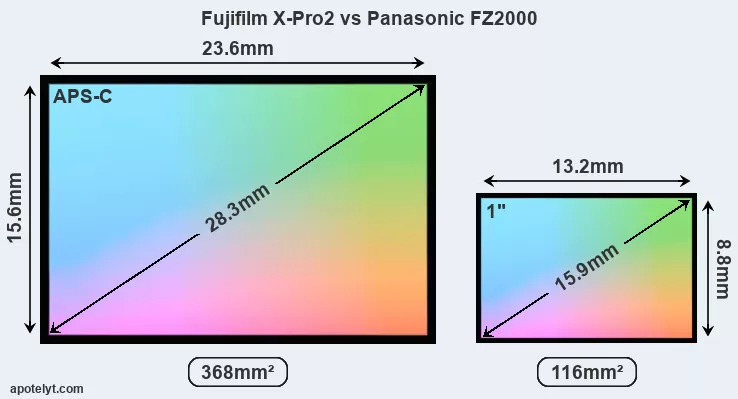
With 24MP, the X-Pro2 offers a higher resolution than the FZ2000 (20MP), but the X-Pro2 nevertheless has larger individual pixels (pixel pitch of 3.92μm versus 2.41μm for the FZ2000) due to its larger sensor. However, the FZ2000 is a somewhat more recent model (by 8 months) than the X-Pro2, and its sensor might have benefitted from technological advances during this time that enhance the light gathering capacity of its pixels. Coming back to sensor resolution, it should be mentioned that the X-Pro2 has no anti-alias filter installed, so that it can capture all the detail its sensor resolves.
The resolution advantage of the Fujifilm X-Pro2 implies greater flexibility for cropping images or the possibility to print larger pictures. The maximum print size of the X-Pro2 for good quality output (200 dots per inch) amounts to 30 x 20 inches or 76.2 x 50.8 cm, for very good quality (250 dpi) 24 x 16 inches or 61 x 40.6 cm, and for excellent quality (300 dpi) 20 x 13.3 inches or 50.8 x 33.9 cm. The corresponding values for the Panasonic FZ2000 are 27.4 x 18.2 inches or 69.5 x 46.3 cm for good quality, 21.9 x 14.6 inches or 55.6 x 37.1 cm for very good quality, and 18.2 x 12.2 inches or 46.3 x 30.9 cm for excellent quality prints.
The X-Pro2 has on-sensor phase detect pixels, which results in fast and reliable autofocus acquisition even during live view operation.
The Fujifilm X-Pro2 has a native sensitivity range from ISO 200 to ISO 12800, which can be extended to ISO 100-51200. The corresponding ISO settings for the Panasonic Lumix DMC-FZ2000 are ISO 125 to ISO 12800, with the possibility to increase the ISO range to 80-25600.
In terms of underlying technology, the X-Pro2 is build around a CMOS sensor, while the FZ2000 uses a BSI-CMOS imager. The X-Pro2 uses Fujifilm's X-Trans layout of photosites, while the FZ2000 employs the more common Bayer array.
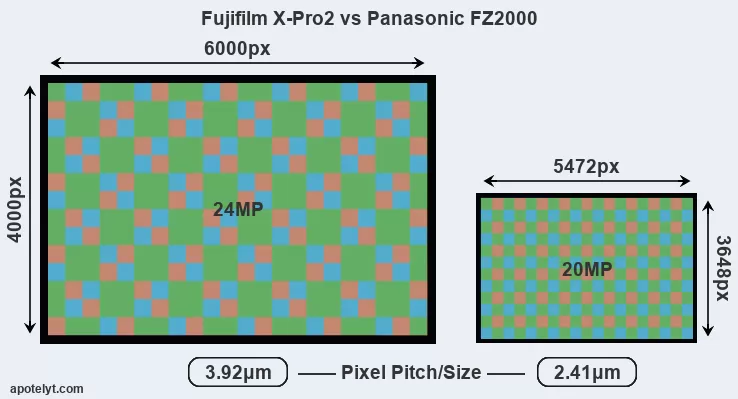
Since 2007, DXO Mark has published sensor performance measurements that have been derived using a consistent methodology. This service is based on lab testing and assigns an overall score to each camera sensor, as well as ratings for dynamic range ("DXO Landscape"), color depth ("DXO Portrait"), and low-light sensitivity ("DXO Sports"). The following table provides an overview of the physical sensor characteristics, as well as the sensor quality measurements for a selection of comparators.

| Camera Model |
Sensor Class |
Resolution (MP) |
Horiz. Pixels |
Vert. Pixels |
Video Format |
DXO Portrait |
DXO Landscape |
DXO Sports |
DXO Overall |
||
|---|---|---|---|---|---|---|---|---|---|---|---|
| 1. | Fujifilm X-Pro2 | APS-C | 24.0 | 6000 | 4000 | 1080/60p | 23.7 | 13.0 | 1608 | 80 | |
| 2. | Panasonic FZ2000 | 1-inch | 20.0 | 5472 | 3648 | 4K/30p | 23.0 | 12.6 | 538 | 70 | |
| 3. | Fujifilm X-A3 | APS-C | 24.0 | 6000 | 4000 | 1080/60p | 23.8 | 13.1 | 1664 | 81 | |
| 4. | Fujifilm X-Pro1 | APS-C | 16.0 | 4896 | 3264 | 1080/24p | 23.1 | 12.3 | 1238 | 74 | |
| 5. | Fujifilm X-Pro3 | APS-C | 26.0 | 6240 | 4160 | 4K/30p | 24.1 | 13.6 | 1968 | 84 | |
| 6. | Fujifilm X-T1 | APS-C | 16.0 | 4896 | 3264 | 1080/60p | 23.5 | 12.7 | 1426 | 77 | |
| 7. | Fujifilm X-T2 | APS-C | 24.0 | 6000 | 4000 | 4K/30p | 23.8 | 13.1 | 1653 | 81 | |
| 8. | Fujifilm X-T3 | APS-C | 26.0 | 6240 | 4160 | 4K/60p | 24.0 | 13.4 | 1853 | 83 | |
| 9. | Fujifilm X100F | APS-C | 24.0 | 6000 | 4000 | 1080/60p | 23.9 | 13.2 | 1704 | 81 | |
| 10. | Fujifilm X100V | APS-C | 26.0 | 6240 | 4160 | 4K/30p | 24.2 | 13.6 | 1996 | 84 | |
| 11. | Nikon D500 | APS-C | 20.7 | 5568 | 3712 | 4K/30p | 24.0 | 14.0 | 1324 | 83 | |
| 12. | Panasonic FZ1000 | 1-inch | 20.0 | 5472 | 3648 | 4K/30p | 22.1 | 11.7 | 517 | 64 | |
| 13. | Sony A6500 | APS-C | 24.0 | 6000 | 4000 | 4K/30p | 24.5 | 13.7 | 1405 | 85 | |
| 14. | Sony RX10 II | 1-inch | 20.0 | 5472 | 3648 | 4K/30p | 23.0 | 12.6 | 531 | 70 | |
| 15. | Sony RX100 IV | 1-inch | 20.0 | 5472 | 3648 | 4K/30p | 22.8 | 12.6 | 591 | 70 | |
| 16. | Sony RX100 V | 1-inch | 20.0 | 5472 | 3648 | 4K/30p | 22.8 | 12.4 | 586 | 70 | |
| Note: DXO values in italics represent estimates based on sensor size and age. | |||||||||||
Many modern cameras are not only capable of taking still images, but can also record movies. Both cameras under consideration have a sensor with sufficiently fast read-out times for moving pictures, but the FZ2000 provides a better video resolution than the X-Pro2. It can shoot movie footage at 4K/30p, while the Fujifilm is limited to 1080/60p.
Feature comparison
Beyond body and sensor, cameras can and do differ across a range of features. The X-Pro2 and the FZ2000 are similar in the sense that both feature an electronic viewfinder, which is helpful when framing images in bright sunlight. Moreover, their viewfinders offer an identical resolution of 2360k dots. The following table reports on some other key feature differences and similarities of the Fujifilm X-Pro2, the Panasonic FZ2000, and comparable cameras.

| Camera Model |
Viewfinder (Type or 000 dots) |
Control Panel (yes/no) |
LCD Specifications (inch/000 dots) |
LCD Attach- ment |
Touch Screen (yes/no) |
Max Shutter Speed * |
Max Shutter Flaps * |
Built-in Flash (yes/no) |
Built-in Image Stab |
||
|---|---|---|---|---|---|---|---|---|---|---|---|
| 1. | Fujifilm X-Pro2 | 2360 | n | 3.0 / 1620 | fixed | n | 1/8000s | 8.0/s | n | n | |
| 2. | Panasonic FZ2000 | 2360 | n | 3.0 / 1040 | swivel | Y | 1/4000s | 12.0/s | Y | Y | |
| 3. | Fujifilm X-A3 | none | n | 3.0 / 1040 | tilting | Y | 1/4000s | 6.0/s | Y | n | |
| 4. | Fujifilm X-Pro1 | 1440 | n | 3.0 / 1230 | fixed | n | 1/4000s | 6.0/s | n | n | |
| 5. | Fujifilm X-Pro3 | 3690 | n | 3.0 / 1620 | tilting | Y | 1/8000s | 8.0/s | n | n | |
| 6. | Fujifilm X-T1 | 2360 | n | 3.0 / 1040 | tilting | n | 1/4000s | 8.0/s | n | n | |
| 7. | Fujifilm X-T2 | 2360 | n | 3.0 / 1040 | full-flex | n | 1/8000s | 8.0/s | n | n | |
| 8. | Fujifilm X-T3 | 3690 | n | 3.0 / 1040 | full-flex | Y | 1/8000s | 11.0/s | n | n | |
| 9. | Fujifilm X100F | 2360 | n | 3.0 / 1040 | fixed | n | 1/4000s | 8.0/s | Y | n | |
| 10. | Fujifilm X100V | 3690 | n | 3.0 / 1620 | tilting | Y | 1/4000s | 11.0/s | n | n | |
| 11. | Nikon D500 | optical | Y | 3.2 / 2359 | tilting | Y | 1/8000s | 10.0/s | n | n | |
| 12. | Panasonic FZ1000 | 2359 | n | 3.0 / 921 | swivel | n | 1/4000s | 12.0/s | Y | Y | |
| 13. | Sony A6500 | 2359 | n | 3.0 / 922 | tilting | Y | 1/4000s | 11.0/s | Y | Y | |
| 14. | Sony RX10 II | 2359 | Y | 3.0 / 1229 | tilting | n | 1/3200s | 14.0/s | Y | Y | |
| 15. | Sony RX100 IV | 2359 | n | 3.0 / 1228 | tilting | n | 1/2000s | 16.0/s | Y | Y | |
| 16. | Sony RX100 V | 2359 | n | 3.0 / 1229 | tilting | n | 1/2000s | 24.0/s | Y | Y | |
| Note: *) Information refers to the mechanical shutter, unless the camera only has an electronic one. | |||||||||||
One differentiating feature between the two cameras concerns the touch sensitivity of the rear screen. The FZ2000 has a touchscreen, while the X-Pro2 has a conventional panel. Touch control can be particularly helpful, for example, for setting the focus point.
The FZ2000 has an articulated screen that can be turned to be front-facing. This characteristic will be appreciated by vloggers and photographers who are interested in taking selfies. In contrast, the X-Pro2 does not have a selfie-screen.The reported shutter speed information refers to the use of the mechanical shutter. Yet, some cameras only have an electronic shutter, while others have an electronic shutter in addition to a mechanical one. In fact, both cameras under consideration feature an electronic shutter, which makes completely silent shooting possible. However, this mode is less suitable for photographing moving objects (risk of rolling shutter) or shooting under artificial light sources (risk of flickering).
The Fujifilm X-Pro2 and the Panasonic FZ2000 both have an intervalometer built-in. This enables the photographer to capture time lapse sequences, such as flower blooming, a sunset or moon rise, without purchasing an external camera trigger and related software.
Concerning the storage of imaging data, both the X-Pro2 and the FZ2000 write their files to SDXC cards. The X-Pro2 features dual card slots, which can be very useful in case a memory card fails. In contrast, the FZ2000 only has one slot. The X-Pro2 supports UHS-II cards (on its first slot), while the FZ2000 can use UHS-I cards.
Connectivity comparison
For some imaging applications, the extent to which a camera can communicate with its environment can be an important aspect in the camera decision process. The table below provides an overview of the connectivity of the Fujifilm X-Pro2 and Panasonic Lumix DMC-FZ2000 and, in particular, the interfaces the cameras (and selected comparators) provide for accessory control and data transfer.

| Camera Model |
Hotshoe Port |
Internal Mic / Speaker |
Microphone Port |
Headphone Port |
HDMI Port |
USB Port |
WiFi Support |
NFC Support |
Bluetooth Support |
||
|---|---|---|---|---|---|---|---|---|---|---|---|
| 1. | Fujifilm X-Pro2 | Y | stereo / mono | Y | - | micro | 2.0 | Y | - | - | |
| 2. | Panasonic FZ2000 | Y | stereo / mono | Y | Y | micro | 2.0 | Y | - | - | |
| 3. | Fujifilm X-A3 | Y | stereo / mono | - | - | micro | 2.0 | Y | - | - | |
| 4. | Fujifilm X-Pro1 | Y | stereo / mono | - | - | mini | 2.0 | - | - | - | |
| 5. | Fujifilm X-Pro3 | Y | stereo / mono | Y | - | - | 3.1 | Y | - | Y | |
| 6. | Fujifilm X-T1 | Y | stereo / mono | Y | - | mini | 2.0 | Y | - | - | |
| 7. | Fujifilm X-T2 | Y | stereo / mono | Y | - | micro | 3.0 | Y | - | - | |
| 8. | Fujifilm X-T3 | Y | stereo / mono | Y | Y | micro | 3.1 | Y | - | Y | |
| 9. | Fujifilm X100F | Y | stereo / mono | Y | - | micro | 2.0 | Y | - | - | |
| 10. | Fujifilm X100V | Y | stereo / mono | Y | - | micro | 3.1 | Y | - | Y | |
| 11. | Nikon D500 | Y | stereo / mono | Y | Y | mini | 3.0 | Y | Y | Y | |
| 12. | Panasonic FZ1000 | Y | stereo / mono | Y | - | micro | 2.0 | Y | Y | - | |
| 13. | Sony A6500 | Y | stereo / mono | Y | - | micro | 2.0 | Y | Y | - | |
| 14. | Sony RX10 II | Y | stereo / mono | Y | Y | micro | 2.0 | Y | Y | - | |
| 15. | Sony RX100 IV | - | stereo / mono | - | - | micro | 2.0 | Y | Y | - | |
| 16. | Sony RX100 V | - | stereo / mono | - | - | micro | 2.0 | Y | Y | - |
Studio photographers will appreciate that the Fujifilm X-Pro2 (unlike the FZ2000) features a PC Sync socket, so that professional strobe lights can be controlled by the camera.
The FZ2000 is a recent model that features in the current product line-up of Panasonic. In contrast, the X-Pro2 has been discontinued (but can be found pre-owned on ebay). As a replacement in the same line of cameras, the X-Pro2 was succeeded by the Fujifilm X-Pro3. Further information on the features and operation of the X-Pro2 and FZ2000 can be found, respectively, in the Fujifilm X-Pro2 Manual (free pdf) or the online Panasonic FZ2000 Manual.
Review summary
So what is the bottom line? Is there a clear favorite between the Fujifilm X-Pro2 and the Panasonic FZ2000? Which camera is better? Below is a summary of the relative strengths of each of the two contestants.

Reasons to prefer the Fujifilm X-Pro2:
- More detail: Offers more megapixels (24 vs 20MP) with a 10% higher linear resolution.
- Maximized detail: Lacks an anti-alias filter to exploit the sensor's full resolution potential.
- Better image quality: Features bigger pixels on a larger sensor for higher quality imaging.
- Richer colors: The pixel size advantage translates into images with better, more accurate colors.
- More dynamic range: Larger pixels capture a wider spectrum of light and dark details.
- Better low-light sensitivity: Larger pixels means good image quality even under poor lighting.
- Better live-view autofocus: Features on-sensor phase-detection for more confident autofocus.
- More detailed LCD: Has a higher resolution rear screen (1620k vs 1040k dots).
- Faster shutter: Has higher mechanical shutter speed (1/8000s vs 1/4000s) to freeze action.
- More flexible: Accepts interchangeable lenses, so that lens characteristics can be altered.
- More compact: Is smaller (141x83mm vs 138x102mm) and thus needs less room in the bag.
- Better sealing: Is weather sealed to enable shooting in dusty or wet environments.
- Better studio light control: Has a PC Sync socket to connect to professional strobe lights.
- Greater peace of mind: Features a second card slot as a backup in case of memory card failure.
- Faster buffer clearing: Supports a more advanced SD data transfer standard (UHS-II vs UHS-I).
- More heavily discounted: Has been on the market for longer (launched in January 2016).

Arguments in favor of the Panasonic Lumix DMC-FZ2000:
- Better moiré control: Has an anti-alias filter to avoid artificial patterns to appear in images.
- Better video: Provides higher definition movie capture (4K/30p vs 1080/60p).
- Better sound control: Has a headphone port that enables audio monitoring while recording.
- Larger viewfinder image: Features a viewfinder with a higher magnification (0.74x vs 0.39x).
- More flexible LCD: Has a swivel screen for odd-angle shots in portrait or landscape orientation.
- Fewer buttons to press: Has a touchscreen to facilitate handling and shooting adjustments.
- More selfie-friendly: Has an articulated screen that can be turned to be front-facing.
- Faster burst: Shoots at higher frequency (12 vs 8 flaps/sec) to capture the decisive moment.
- Ready to shoot: Has an integrated lens, whereas the X-Pro2 necessitates an extra lens.
- Sharper images: Has stabilization technology built-in to reduce the impact of hand-shake.
- Easier fill-in: Has a small integrated flash to brighten shadows of backlit subjects.
- More affordable: Was introduced at a lower price, despite coming with a built-in lens.
- More modern: Was introduced somewhat (8 months) more recently.
If the count of relative strengths (bullet points above) is taken as a measure, the X-Pro2 emerges as the winner of the contest (16 : 13 points). However, the relevance of individual strengths will vary across photographers, so that you might want to apply your own weighing scheme to the summary points when reflecting and deciding on a new camera. A professional wedding photographer will view the differences between cameras in a way that diverges from the perspective of a travel photog, and a person interested in cityscapes has distinct needs from a macro shooter. Hence, the decision which camera is best and worth buying is often a very personal one.
How about other alternatives? Do the specifications of the Fujifilm X-Pro2 and the Panasonic FZ2000 place the cameras among the top in their class? Find out in the latest Best Mirrorless Interchangeable Lens Camera and Best Superzoom Camera listings whether the two cameras rank among the cream of the crop.
In any case, while the comparison of the spec-sheets of cameras can offer a general idea of their imaging potential, it says little about, for example, the shooting experience and imaging performance of the X-Pro2 and the FZ2000 in practical situations. User reviews that are available, for instance, at amazon can sometimes shed light on these issues, but such feedback is all too often partial, inconsistent, and inaccurate.
Expert reviews
This is where reviews by experts come in. The adjacent summary-table relays the overall verdicts of several of the most popular camera review sites (amateurphotographer [AP], cameralabs [CL], digitalcameraworld [DCW], dpreview [DPR], ephotozine [EPZ], photographyblog [PB]). As can be seen, the professional reviewers agree in many cases on the quality of different cameras, but sometimes their assessments diverge, reinforcing the earlier point that a camera decision is often a very personal choice.

| Camera Model |
AP score |
CL score |
DCW score |
DPR score |
EPZ score |
PB score |
Camera Launch |
Launch Price (USD) |
Street Price |
||
|---|---|---|---|---|---|---|---|---|---|---|---|
| 1. | Fujifilm X-Pro2 | .. | + | .. | 83/100 | 4.5/5 | 4.5/5 | Jan 2016 | 1,699 | ebay.com | |
| 2. | Panasonic FZ2000 | .. | + | .. | 82/100 | 4.5/5 | 5/5 | Sep 2016 | 1,199 | amazon.com | |
| 3. | Fujifilm X-A3 | .. | .. | .. | 74/100 | 4.5/5 | 4/5 | Aug 2016 | 399 | ebay.com | |
| 4. | Fujifilm X-Pro1 | 5/5 | + + | .. | 79/100 | 4.5/5 | 4.5/5 | Jan 2012 | 1,699 | ebay.com | |
| 5. | Fujifilm X-Pro3 | 4/5 | + | 4/5 | 85/100 | 4/5 | .. | Oct 2019 | 1,799 | amazon.com | |
| 6. | Fujifilm X-T1 | 5/5 | + + | .. | 84/100 | 5/5 | 5/5 | Jan 2014 | 1,299 | ebay.com | |
| 7. | Fujifilm X-T2 | 5/5 | + + | .. | 86/100 | 4.5/5 | 5/5 | Jul 2016 | 1,599 | ebay.com | |
| 8. | Fujifilm X-T3 | 5/5 | + + | 4.5/5 | 88/100 | 5/5 | 5/5 | Sep 2018 | 1,499 | ebay.com | |
| 9. | Fujifilm X100F | 5/5 | + | 3.9/5 | 83/100 | 4.5/5 | 4.5/5 | Jan 2017 | 1,299 | ebay.com | |
| 10. | Fujifilm X100V | 5/5 | + + | 4.5/5 | 86/100 | 5/5 | 4.5/5 | Feb 2020 | 1,399 | ebay.com | |
| 11. | Nikon D500 | 5/5 | + + | 4.7/5 | 91/100 | 4.5/5 | 5/5 | Jan 2016 | 1,999 | ebay.com | |
| 12. | Panasonic FZ1000 | 4/5 | + + | .. | 82/100 | 4.5/5 | 4.5/5 | Jun 2014 | 899 | ebay.com | |
| 13. | Sony A6500 | 5/5 | + + | 3.5/5 | 85/100 | 4.5/5 | 4.5/5 | Oct 2016 | 1,399 | ebay.com | |
| 14. | Sony RX10 II | 5/5 | + + | .. | 82/100 | 4.5/5 | 4/5 | Jun 2015 | 1,299 | ebay.com | |
| 15. | Sony RX100 IV | 4.5/5 | + + | .. | 85/100 | 4/5 | 4.5/5 | Jun 2015 | 999 | ebay.com | |
| 16. | Sony RX100 V | 4.5/5 | + + | .. | 83/100 | 4/5 | 4.5/5 | Oct 2016 | 999 | ebay.com | |
| Note: (+ +) highly recommended; (+) recommended; (o) reviewed; (..) not available. | |||||||||||
The above review scores should be interpreted with care, though. The ratings are only valid when referring to cameras in the same category and of the same age. A score, therefore, has to be seen in close connection to the price and market introduction time of the camera, and comparisons of ratings among very different cameras or across long time periods have little meaning. It should also be noted that some of the review sites have over time altered the way they render their verdicts.

Check X-Pro2 offers at
ebay.com

Check FZ2000 price at
amazon.com
Other camera comparisons
Did this review help to inform your camera decision process? If you would like to see a different side-by-side camera review, just use the search menu below. There is also a set of direct links to comparison reviews that other users of the CAM-parator app explored.
- Canon G5 X Mark II vs Panasonic FZ2000
- Canon Rebel vs Panasonic FZ2000
- Canon SX620 vs Fujifilm X-Pro2
- Canon T1i vs Fujifilm X-Pro2
- Epson R-D1 vs Fujifilm X-Pro2
- Fujifilm X-Pro2 vs Panasonic G80
- Fujifilm X-Pro2 vs Sony A7
- Fujifilm X-Pro2 vs Sony A850
- Fujifilm X10 vs Panasonic FZ2000
- Leica Digilux 3 vs Panasonic FZ2000
- Leica S-E Typ 006 vs Panasonic FZ2000
- Panasonic FZ2000 vs Sony A6300
Specifications: Fujifilm X-Pro2 vs Panasonic FZ2000
Below is a side-by-side comparison of the specs of the two cameras to facilitate a quick review of their differences and common features.
| Camera Model | Fujifilm X-Pro2 | Panasonic FZ2000 |
|---|---|---|
| Camera Type | Mirrorless system camera | Fixed lens compact camera |
| Camera Lens | Fujifilm X mount lenses | 24-480mm f/2.8-4.5 |
| Launch Date | January 2016 | September 2016 |
| Launch Price | USD 1,699 | USD 1,199 |
| Sensor Specs | Fujifilm X-Pro2 | Panasonic FZ2000 |
| Sensor Technology | CMOS | BSI-CMOS |
| Sensor Format | APS-C Sensor | 1" Sensor |
| Sensor Size | 23.6 x 15.6 mm | 13.2 x 8.8 mm |
| Sensor Area | 368.16 mm2 | 116.16 mm2 |
| Sensor Diagonal | 28.3 mm | 15.9 mm |
| Crop Factor | 1.5x | 2.7x |
| Sensor Resolution | 24 Megapixels | 20 Megapixels |
| Image Resolution | 6000 x 4000 pixels | 5472 x 3648 pixels |
| Pixel Pitch | 3.92 μm | 2.41 μm |
| Pixel Density | 6.52 MP/cm2 | 17.18 MP/cm2 |
| Moiré control | no AA filter | Anti-Alias filter |
| Movie Capability | 1080/60p Video | 4K/30p Video |
| ISO Setting | 200 - 12,800 ISO | 125 - 12,800 ISO |
| ISO Boost | 100 - 51,200 ISO | 80 - 25,600 ISO |
| Image Processor | X Processor Pro | Venus |
| DXO Sensor Quality (score) | .. | 70 |
| DXO Color Depth (bits) | .. | 23 |
| DXO Dynamic Range (EV) | .. | 12.6 |
| DXO Low Light (ISO) | .. | 538 |
| Screen Specs | Fujifilm X-Pro2 | Panasonic FZ2000 |
| Viewfinder Type | Electronic viewfinder | Electronic viewfinder |
| Viewfinder Field of View | 100% | 100% |
| Viewfinder Magnification | 0.39x | 0.74x |
| Viewfinder Resolution | 2360k dots | 2360k dots |
| LCD Framing | Live View | Live View |
| Rear LCD Size | 3.0inch | 3.0inch |
| LCD Resolution | 1620k dots | 1040k dots |
| LCD Attachment | Fixed screen | Swivel screen |
| Touch Input | no Touchscreen | Touchscreen |
| Shooting Specs | Fujifilm X-Pro2 | Panasonic FZ2000 |
| Focus System | On-Sensor Phase-detect | Contrast-detect AF |
| Manual Focusing Aid | Focus Peaking | Focus Peaking |
| Max Shutter Speed (mechanical) | 1/8000s | 1/4000s |
| Continuous Shooting | 8 shutter flaps/s | 12 shutter flaps/s |
| Electronic Shutter | up to 1/32000s | up to 1/16000s |
| Time-Lapse Photography | Intervalometer built-in | Intervalometer built-in |
| Fill Flash | no On-Board Flash | Built-in Flash |
| Storage Medium | SDXC cards | SDXC cards |
| Single or Dual Card Slots | Dual card slots | Single card slot |
| UHS card support | Single UHS-II | UHS-I |
| Connectivity Specs | Fujifilm X-Pro2 | Panasonic FZ2000 |
| External Flash | Hotshoe | Hotshoe |
| Studio Flash | PC Sync socket | no PC Sync |
| USB Connector | USB 2.0 | USB 2.0 |
| HDMI Port | micro HDMI | micro HDMI |
| Microphone Port | External MIC port | External MIC port |
| Headphone Socket | no Headphone port | Headphone port |
| Wifi Support | Wifi built-in | Wifi built-in |
| Body Specs | Fujifilm X-Pro2 | Panasonic FZ2000 |
| Environmental Sealing | Weathersealed body | not weather sealed |
| Battery Type | Fujifilm NP-W126 | Panasonic DMW-BLC12 |
| Battery Life (CIPA) | 350 shots per charge | 350 shots per charge |
| Body Dimensions |
141 x 83 x 46 mm (5.6 x 3.3 x 1.8 in) |
138 x 102 x 135 mm (5.4 x 4.0 x 5.3 in) |
| Camera Weight | 495 g (17.5 oz) | 915 g (32.3 oz) |

Check X-Pro2 offers at
ebay.com

Check FZ2000 price at
amazon.com
Did you notice an error on this page? If so, please get in touch, so that we can correct the information.
